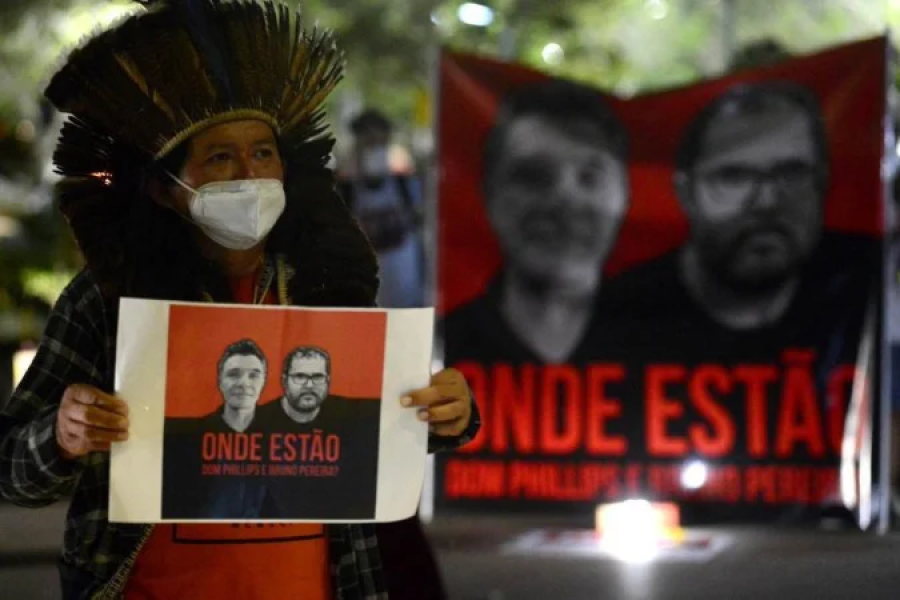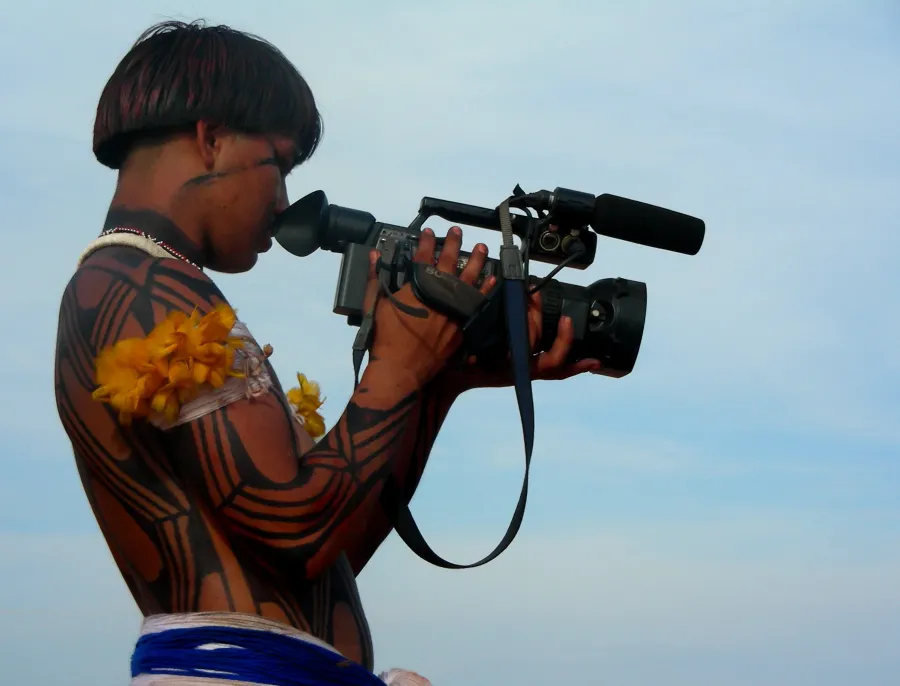The Multilateral Development Banks (MDBs), with their massive development projects, affect the lives of indigenous peoples and the environment every day. But it has been hard to find ways for indigenous peoples, indigenists, and those concerned with the environment to affect their decisions.
Over the last eighteen months, a campaign to do just that has brought together major US environmental organizations and indigenous rights groups. The campaign, coordinated by attorney Bruce Rich, of the Natural Resources Defense Council (NRDC) has combined legislative lobbying, direct pressure and publicity in a series of initiatives that are showing some effect on the MDBs.
Previous Campaigns
The present campaign is not the first attempt to raise questions of development and indigenous peoples' rights in Congress. As a result of lobbying by the Anthropology Resource Center in September 1978 there was a hearing on Brazil's Development Policies and Effects on Indians in the Amazon before the House Subcommittee on International Development. Environmental groups such as NRDC and the Environmental Defense Fund (EDF) launched a successful lawsuit in 1975 that forced USAID to adopt environmental impact assessments. NRDC, Cultural Survival and Survival International USA (SIUSA) also attempted to influence USAID's involvement in the Pichis-Palcazu project in Peru. Major changes were made in response to the criticisms.
In April 1983, The Eighth Annual National Conference on Rivers, sponsored by the Environmental Policy Institute (EPI), included a workshop organized by Robin Wright of ARC to examine human consequences of large dams internationally. As a result of the interest in international development projects generated at this conference. Brent Blackwelder, a conference organizer and director of the Water Resources Project of EPI, Bruce Rich, and Barbara Bramble, director of the National Wildlife Federation's (NWF) International Program, drafted an amendment to MDB authorization legislation then before the House Subcommittee on International Development Institutions and Finance (of the Committee on Banking, Finance, and Urban Affairs). The amendment called for improved environmental assessment and performance on the part of the MDBs. Rep. Mike Lowry of Washington, a long time defender of Indian treaty rights, moved to introduce the amendment and the subcommittee resolved to hold hearings.
The result was hearings on June 28 and 29, 1983, March 26, and September 11 and 13, 1984 on a range of environmental and human rights issues. Many of the points raised in testimony by representatives of such organizations as NRDC, EPI, NWF, the Sierra Club, the National Congress of American Indians, Cultural Survival and ARC were adopted in recommendations by the subcommittee to the US executive directors of the MDBs and the US Treasury Department. While the recommendations are largely directed to environmental questions - increased environmental staffing in the MDBs, improved environmental training programs, creation of a staff position in Treasury's office of MDBs to monitor environment, increased involvement of host country conservation NGOs in project planning and monitoring - it is also advised that US Executive Directors either insist on changes in or oppose funding of projects that threaten the land or resource base of indigenous peoples. Further, lobbying on behalf of SIUSA persuaded the subcommittee to recommend that indigenous peoples' NGOs, as well as conservation NGOs, be consulted about environmental protection in project planning, implementation, and monitoring. James Conrow, Deputy Assistant Secretary for the Treasury Department, supported the recommendation in his statement to the subcommittee, and also supported the recommendations calling for participation of indigenous peoples.
The recommendations - and the support for them from the Treasury Department - are significant because the Subcommittee on International Development and Finance has been a major source of support for the MDBs in congress. While the existence of the recommendations does not mean that they will be put into effect, they provide a point of reference for attempts to influence development policy and projects that cannot be ignored by the MDBs since they are offered by the banks' major allies in the US government.
The Polonoroeste Initiative
Another aspect of the emerging coalition can be traced to the 1980-81 campaign to call attention to the situation of the indigenous peoples in the area of the Northwest Brazil Development Program (Polonoroeste). In 1980, when the World Bank was planning the program. Cultural Survival, SIUSA and ARC published materials and wrote letters to the World Bank pointing out the danger the project posed for indigenous peoples and the inadequacy of existing provisions to protect their interest.
Protest of the project was based on the information of anthropologist David Price, former FUNAI employee and one-time consultant to the World Bank, whose criticisms of the project touched off a scandal within the Bank. Price, through the support of Cultural Survival, was one of the witnesses at the June 1983 hearings, and while the hearings and elaboration of recommendations were still in progress, more recent information from Brazil suggested that the project was indeed encountering grave problems. While the core of the project, the paving of the Cuiabá-Porto Velho highway, was ahead of schedule, provisions to protect the Indians' rights and the environment remained unimplemented. Most indigenous lands in the area were not demarcated, ecological reserves were not set aside, and massive migration in the absence of an adequate settlement program was resulting in explosively increasing deforestation and pressure on indigenous lands. NRDC's International Project collected information on the program and produced drafts of a letter to the president of the World Bank and factual memoranda dealing with environment and indigenous peoples. These were then sent to environmental, academic and indigenous organizations in the US, Brazil and Europe requesting comment and support.
Meanwhile, the case of Polonoroeste was brought to the attention of Rep. James Scheuer of New York, chairman of the House Subcommittee on Natural Resources, Agricultural Research and Environment of the Committee on Science and Technology. A hearing on Agricultural Development Projects and Deforestation in Latin America was organized. On 19 September 1984 the subcommittee heard testimony from Brazilian agronomist and founder of the Associaçao Gaucha de Proteçao ao Ambiente Natural (AFAPAN) Jose Lutzenberger and other expert witnesses, and saw parts of the television program Decade of Destruction, filmed in the project area in Rondônia. Impressed with the testimony. Rep. Scheuer then sent a letter to the Secretary of the Treasury urging that a series of specific measures be taken to rectify the situation in Rondônia. Lutzenberger's testimony was featured on Globo TV in Brazil, going to some 30,000,000 viewers.
On October 15, the NRDC letter and memoranda on Polonoroeste, signed by representatives of 31 organizations from 10 countries, was delivered to the World Bank. Cosigners included environmental organizations such as Friends of the Earth, the National Audubon Society, NWF and EDF, as well as the American Anthropological Association, the Brazilian Anthropological Association, the Brazilian Bar Association, legislators from Brazil and West Germany, and international and Brazilian indigenist groups. The letter was the subject of an October 17 news story in The New York Times and received coverage in Brazil including a story on the Voice of America. A complementary letter from Brazilian anthropologists Betty Mindlin and Carmen Junqueira, who have monitored the project through the Economic Research Foundation of Sao Paulo pointed out many of the same problems.
Implications of the Campaign
One strength of the campaign as a whole is that various tactics have been used - congressional hearings, direct international pressure on the World Bank to improve a specific project, media coverage, in the US and abroad - to influence the MDBs. The Polonoroeste campaign appears to have had an effect. At the World Bank the project is in mid-term review and it is likely that changes will be proposed. Various sources suggest that disbursements for the program may be halted unless rapid and substantive improvements are made. Sources in Brazil indicate that while conditions in the project area are poor and worsening, the Ministry of the Interior and the National Indian Foundation have felt increased pressure to implement the environmental and indigenous peoples' provisions of the loan agreement. At the same time, it is said that the Inter-American Development Bank is considering funding a project that would pave another stretch of the BR-364 highway, from Porto Velho to Rio Branco in Acre, which, should it proceed without adequate environmental safeguards and steps to guarantee indigenous lands, would amplify the very serious problems apparent in the Polonoroeste area.
Perhaps most important in the long run, networks have been established between environmentalist and indigenist organizations and a long term coalition oriented toward questions of resource use and local self-determination in development is emerging. Clearly, environmental organizations, with their large national memberships, extensive legal expertise and electoral weight have much to offer indigenist groups. The indigenous in return have networks and information of great value for international projects. Up-to-date information on MDB-funded projects in the Third World is often not widely available in the US and anthropologists and indigenists with research experience in these countries can break the MDB's monopoly on such information. In the case of Polonoroeste, contacts with Brazilian anthropologists and indigenists, initially through the Ecumenical Center for Documentation and Information (CEDI) and the Indigenous Populations Work Group of the Brazilian Bar Association, were invaluable not only in documenting the situation in the project area, and in organizing support for the initiative, but also in putting European anthropologists in contact with the coalition. In turn, publicity for such initiatives, as in Lutzenburger's testimony before Congress, can return the information in the form of "international news."
This cooperation between environmental and indigenous groups could be the beginning of a broad-based campaign to increase the environmental soundness of and local control over development. Recently, for example, NWF, EPI, and NRDC sent letters to Brazil urging the president of FUNAI not to sign decree 88.985, which would permit mechanized mining on indigenous lands all over Brazil. Cultural Survival sent a telegram to Brazil about the same decree and a copy of the telegram to the Indigenous Peoples Network of 700 members asking that they do the same. Native American organizations in Washington D.C. were also approached on this subject. Further hearings before Rep. Scheuer's subcommittee dealing with agricultural development in Africa and Asia have been discussed. If further results are to be achieved, the momentum must be sustained.




